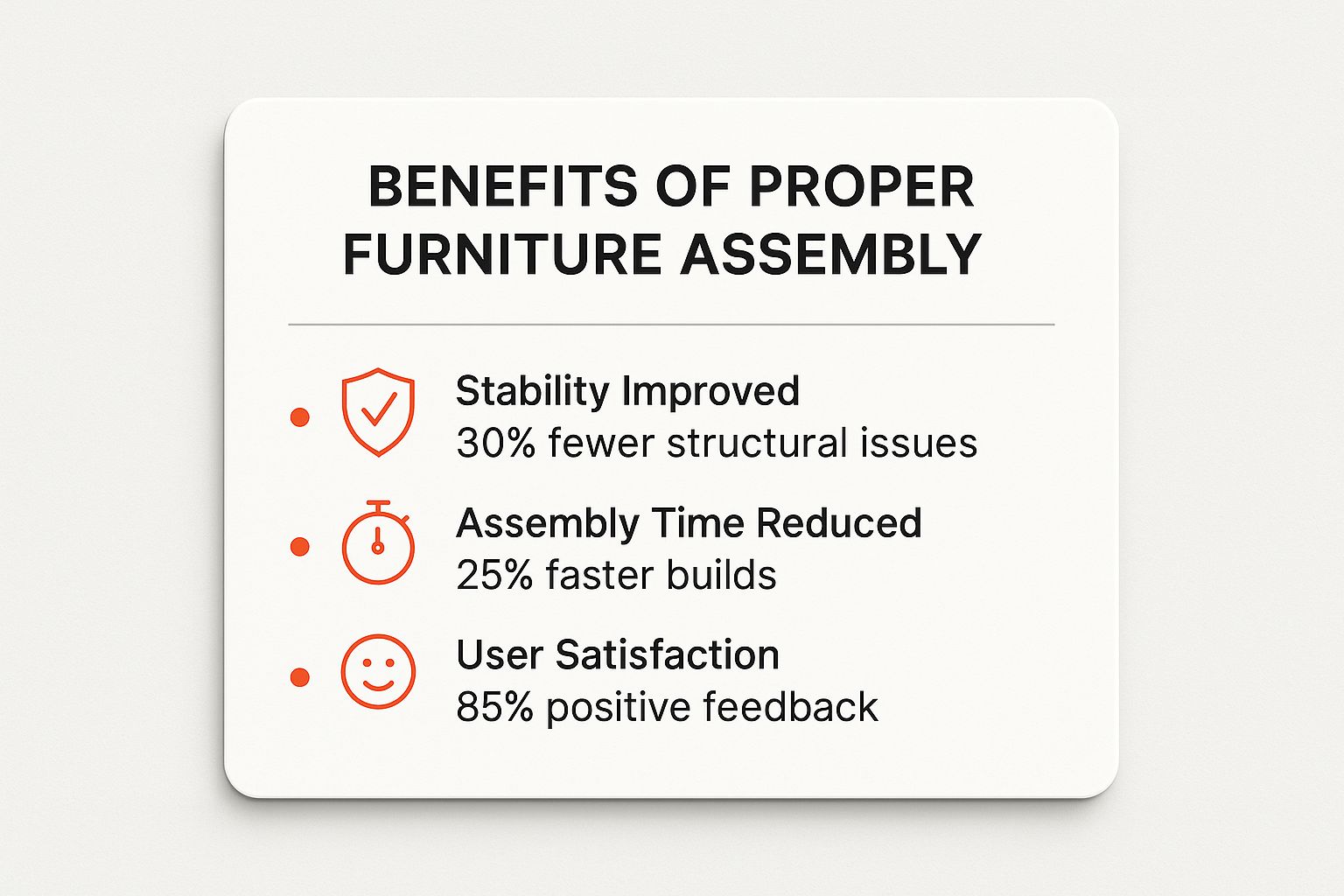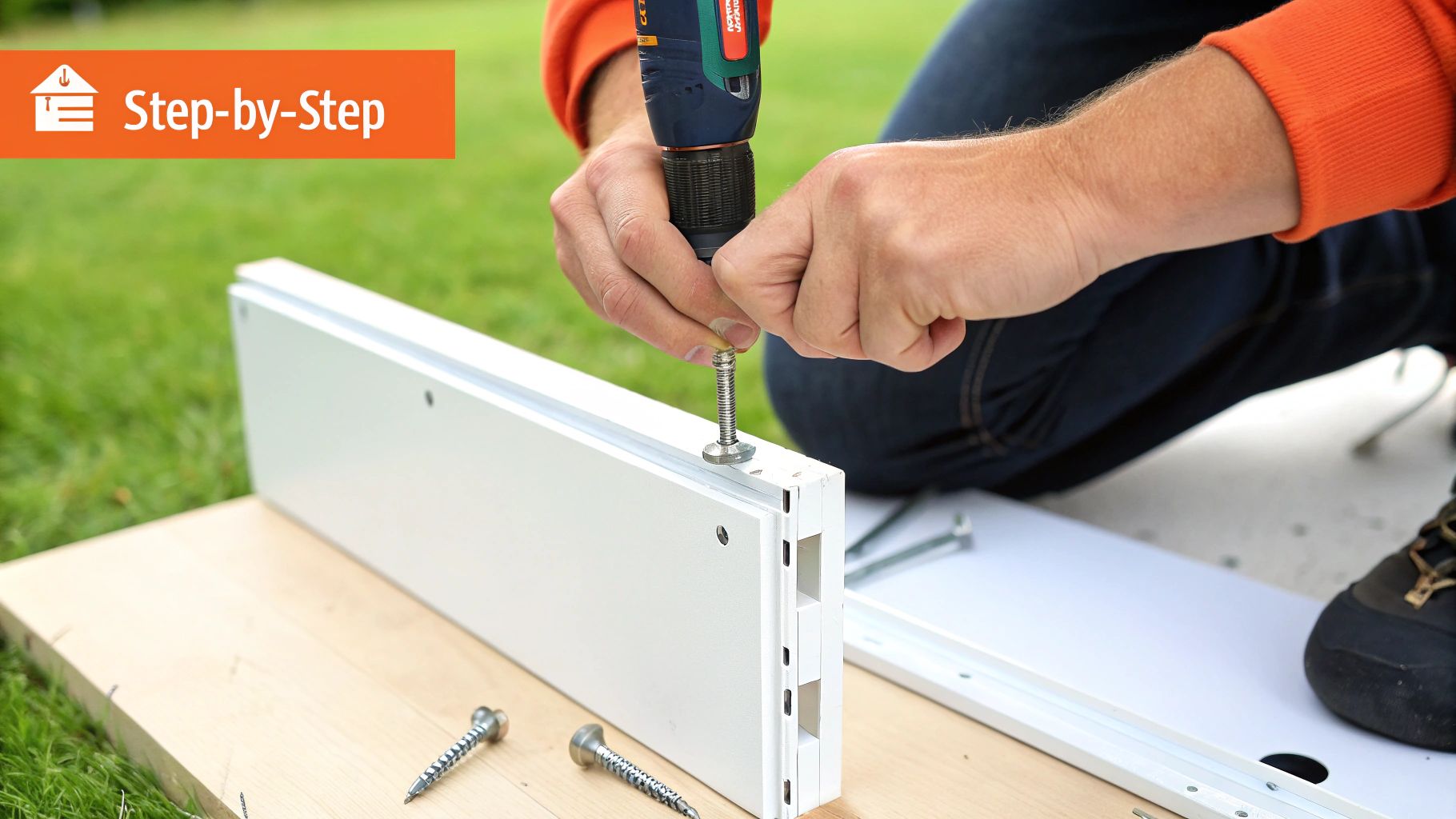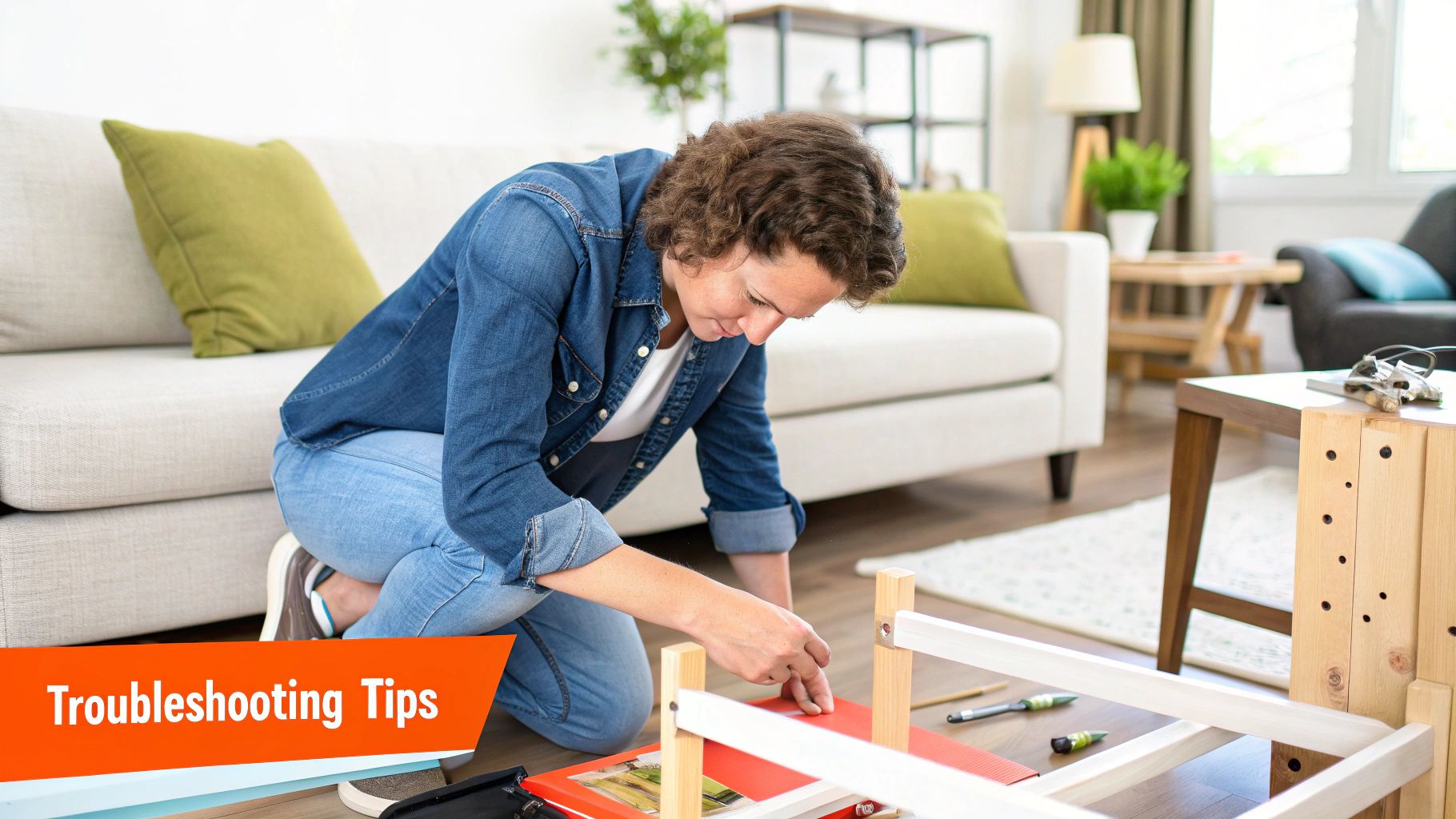-
CALL US:
- (866) 952-3456
The real cost of putting together that new piece of furniture isn't just what's on the price tag. We've all been there. What looks like a simple weekend project can quickly spiral into a mess of confusing instructions, a pile of mystery screws, and a whole lot of frustration. This isn't just about the money; it's about what your time, effort, and sanity are truly worth versus calling in professional furniture assembly help.
There’s a certain satisfaction that comes with doing it yourself, not to mention saving a few bucks. But let's be honest—assembling modern flat-pack furniture is rarely as simple as the instructions make it seem. The "cost" of DIY often includes:
It only takes one misplaced screw or an overtightened bolt to weaken the whole structure or ruin the finish. This is where you really see the gap between the clean diagrams and the messy reality of putting things together.
Let's talk about those instruction manuals. Vague diagrams and one-size-fits-all steps don't account for the unique quirks of your home or the specific tools you need for a truly solid build. A wobbly bookcase or a crooked cabinet door isn't just an eyesore; it's a red flag that the assembly might not be safe or built to last.
I’ve seen it time and again: the biggest hidden cost is the final product itself. An improperly assembled item doesn’t just look off—it can break down way too soon, turning your money-saving project into a costly replacement down the road.
This infographic breaks down just how much proper assembly matters.

As you can see, getting it done right the first time dramatically reduces structural problems and build times while making you much happier with the result.
The explosion of ready-to-assemble (RTA) furniture has created a huge demand for people who can solve these exact headaches. In fact, the global furniture assembly services market was valued at a whopping USD 8.5 billion in 2023 and is only expected to grow. Why? Because more and more people are realizing their time is valuable and they’d rather have a guaranteed, professional result.
Here's a quick comparison to help you decide whether to tackle that flat-pack project yourself or bring in an expert.
| Factor | DIY Assembly | Professional Help |
|---|---|---|
| Cost | Lower upfront cost (just the product price). | Higher upfront cost (service fee). |
| Time | Can take several hours, or even days. | Typically fast, often just a few hours. |
| Tools | You need to have the right tools on hand. | The expert brings all necessary tools. |
| Stress | Can be high, especially with confusing instructions. | Minimal. You can relax while it's done for you. |
| Quality | Varies based on skill. Risk of wobbly or damaged items. | Guaranteed professional quality and durability. |
| Warranty | Damage during assembly is on you. | Pros often offer a warranty on their workmanship. |
Ultimately, it comes down to what makes the most sense for you. Some people genuinely enjoy the challenge, while others would rather skip the hassle entirely.
You really have to ask yourself if the potential hours of frustration are worth the savings. Understanding the total investment—in both time and money—is key. For those of you weighing the options, our guide on furniture assembly costs offers a fantastic breakdown to help you budget. And for bigger jobs, looking at a comprehensive cabinet installation guide can give you a real sense of the work involved, helping you make a truly informed decision.
Here is the rewritten section, crafted to sound like an experienced human expert.
Let's be real: calling for help with furniture assembly isn't admitting defeat. It’s a smart move, especially when a project is way more complex than the little diagrams in the instruction booklet let on.
Think about tackling a massive, multi-door wardrobe. You’re trying to get every single hinge and panel perfectly aligned. Without the right touch—and the right tools—you could easily burn an entire weekend wrestling with dozens of parts, only to end up with a wobbly mess.
Sometimes, it just makes sense to call in a pro. This is especially true for:
Then there are the items where safety is everything. For things like cribs, bunk beds, and heavy wall-mounted units, a flawless build isn't just nice to have—it's non-negotiable for your family's safety and your own peace of mind.
It's no surprise that professional assembly services are booming, particularly among younger city dwellers who love ready-to-assemble furniture but don't love the hassle. They get that their time is valuable and would rather skip the frustration that comes with deciphering confusing flat-pack instructions. You can even see the data on these demographic trends if you're curious.
Hiring a professional ensures every bolt is tightened just right and every panel is perfectly level. They have the experience to spot potential issues before they become real problems.
Plus, any reputable service carries insurance and warranties. This covers you in the rare case of accidental damage or if something isn't aligned correctly after they leave.
Here's the bottom line: A certified pro not only minimizes the risk of injury but also protects your investment with guaranteed work.
Let's face it, a busy schedule can turn what seems like a simple build into a weekend-long ordeal. After a long workweek, the last thing most of us want to do is spend hours drilling dozens of pilot holes or trying to make sense of technical guides.
Hiring a specialist means:
Ultimately, bringing in an expert saves you time and delivers a sturdy, reliable piece of furniture you can actually trust. With transparent pricing and insured service from Assembly Smart, you get fewer surprises and a whole lot more peace of mind. Check out our detailed guide on why you should hire a professional to build IKEA furniture for you.
Going the DIY route can definitely save you some cash upfront. But it often costs you in other ways—namely, your time and your sanity, especially when a tool breaks or you can't figure out a crucial step.
Professionals, on the other hand, show up ready to go. They have the power drills, laser levels, and specialized bits to make quick work of even the most complicated builds.
I remember a real-world scenario with a client who was renting and moved frequently. They had a mountain of boxes for a huge wardrobe and nowhere to store tools. They hired us, and by that evening, their new wardrobe was built perfectly, with zero damage or delays. That's the kind of peace of mind you're paying for.
Professional service transforms a stressful chore into a satisfying result.
Every time.

Okay, so you’ve decided to hire out the assembly. Smart move. Now comes the part where you find someone you can actually trust with your new furniture.
It’s important to know that not all furniture assembly help is the same. You'll find everything from solo handypeople on local apps to specialized national outfits like Assembly Smart. Each one has its own vibe and level of service.
A local handyperson might quote a lower price, which is always tempting. But a dedicated assembly service usually brings a more structured, buttoned-up experience to the table. They often have standardized training programs for their techs, proper insurance (a big one!), and a real customer service team you can call if something goes wrong.
Think of it this way: it’s the difference between hiring a freelancer for a logo and working with a design agency. The freelancer might be cheaper, but the agency typically offers more security, accountability, and a predictable process.
When you start looking, you're going to see a ton of reviews. Don't just glance at the star ratings and move on. You need to dig in and see what people are really saying.
Look for reviews that get into the specifics:
A generic five-star review that just says, "Great service!" is nice, but it doesn't tell you much. The review that details how a pro expertly handled a tricky wall-mount installation for a heavy bookcase? That's gold. Those stories paint a much clearer picture of what you can expect on assembly day.
A pattern of reviews mentioning punctuality, efficiency, and respect for the customer’s home is a massive green flag. It shows a consistent commitment to quality service, not just a one-off good day.
Before you pull the trigger and book someone, it’s smart to ask a few key questions. This isn't about giving them the third degree; it's about being an informed customer and making sure there are no nasty surprises down the road. Any truly professional service will be happy to answer.
Here’s a quick checklist of things you’ll want to confirm.
Taking a few extra minutes to properly vet your options is the single best thing you can do to make sure you get a skilled pro who will treat your home and your new stuff with care. It turns a potential gamble into a guaranteed great result.

A truly great assembly experience doesn't just start when the technician rings your doorbell. It actually begins with a little prep work on your end. Taking a few simple steps beforehand can turn what could be a chaotic day into a smooth, efficient process, letting your pro get right to work without any hiccups.
The single most important thing you can do? Clear the workspace. Seriously. A good rule of thumb is to measure the furniture's final footprint and then double that amount of space. This gives the assembler enough elbow room to lay out all the parts, move big pieces around, and work safely without knocking over a lamp or scuffing a wall. A cramped space is just a recipe for delays and accidents.
With the area cleared, it's time to give the boxes a quick once-over. A little inventory check before the appointment can save a massive headache later on.
I can't stress this enough: one of the biggest mistakes people make is tearing open the sealed hardware packets. These are almost always sorted and labeled for specific steps in the instructions. Once they're opened, you've got a confusing jumble of look-alike screws, which causes huge delays. Just leave all the sealed hardware packs untouched.
These little steps make a world of difference. For a more detailed guide, you can check out our full post on how to prepare for your furniture assembly project.
Finally, think about the simple logistics of the day. Make sure there’s a clear path from your front door all the way to the assembly area. If you're in an apartment, find out if you need to book a service elevator ahead of time. It's also incredibly important to keep pets and small children safely out of the work zone—this protects them and allows the technician to focus 100% on getting the job done right. This kind of preparation is what makes for a quick and flawless assembly day.
Once you’ve booked your appointment, the hard part is over. You can mostly relax, but it’s still smart to know what a professional service visit actually looks like. Knowing the play-by-play helps you feel confident that the job is being handled correctly from start to finish.
A top-notch assembly isn’t just about screwing parts together. It’s a methodical service designed for safety, precision, and your total satisfaction.
When the technician arrives, the first thing they'll do is confirm which item they're building and give your prepared workspace a quick once-over. A true pro will then lay down blankets or cardboard to protect your floors before they even touch a box. It’s a small detail, but it speaks volumes about their respect for your home.
Next up is unboxing. They’ll carefully unpack all the components, making sure not to scuff or damage any of the finishes. Then comes a quick but critical inventory of the major pieces and, most importantly, the hardware. They need to know everything is there before the first screw goes in.
With all the parts laid out, the real work begins. A seasoned assembler works efficiently, relying on their own specialized tools to make sure every connection is secure and every panel is perfectly aligned. They follow the manufacturer’s instructions to the letter to protect the item’s structural integrity.
This is where their experience really pays off. Those confusing diagrams that look like a puzzle to most of us are a straightforward roadmap for them, especially if they've built items from that brand before.
As the furniture takes shape, they perform quality checks along the way—it's not something saved for the end. They're constantly making sure:
The final walkthrough is your chance to give the thumbs-up. A great assembler won't just show you the finished piece; they'll encourage you to interact with it. Go ahead and open the drawers, give it a gentle push to check for wobbles, and ask any questions on your mind.
Once you’ve given your approval, the final step is a complete cleanup. The tech will gather all the packaging—the cardboard, plastic wrap, and styrofoam—and put it wherever you’d like. They leave your room looking tidy, with nothing left behind but your brand-new, perfectly assembled furniture.
After the technician heads out, you should feel completely at ease with your new furniture. Any reputable service will back up their work with a solid guarantee, giving you lasting peace of mind.
To learn more about what separates a rookie from a seasoned expert, check out our guide to professional furniture assembly. It details all the key signs of a quality service you can trust.
Even after you've decided to call in a pro, a few last-minute questions might pop into your head. It's totally normal. Getting clear, straightforward answers is the final step to feeling confident you've made the right call.
Let's walk through some of the most common things people ask, covering everything from tipping etiquette to how a real pro handles those nightmare scenarios—like a missing part.
This is probably the number one fear for anyone who's ever opened a flat-pack box. For a professional assembler, though, it's just part of the job. It happens.
If a technician unboxes everything and discovers a cracked panel or a missing bag of screws, they won't just pack up and leave you hanging. First, they’ll stop immediately and show you exactly what the problem is.
Then, they'll work with you to pinpoint the exact part number in the instruction manual. This is a game-changer. Calling customer service and saying "I'm missing a long screw" gets you nowhere fast. But when you can request "Part #7B for the Malm dresser," you'll get a replacement part shipped out quickly. The assembler can even advise you on the best way to contact the retailer. Most services will then schedule a return visit to finish the job as soon as your new part arrives.
This comes up a lot. The short answer? Tipping is never required, but it's always, always appreciated. If you feel the technician did a fantastic job and made your life easier, a tip is a great way to acknowledge their effort.
So, what makes for tip-worthy service? Think about these things:
For a standard job, a tip of $10 to $20 per assembler is pretty common. On larger, more complicated projects, some people opt for 10-20% of the total bill. At the end of the day, it's your call, based entirely on how happy you are with the work.
The goal of any great technician is to provide service so good you want to show your appreciation. Their professionalism and skill should speak for themselves, making your decision an easy one.
This really boils down to what's being built. A simple nightstand might be done in under an hour. A massive wardrobe with sliding doors, interior lights, and a dozen drawers? That could easily take four hours or more.
When you book your appointment, a good company will give you a solid time estimate based on the specific piece of furniture.
Several factors can affect the final time:
For the most accurate quote, always provide the exact product name or, even better, a link to the product page when you book.
Let's be honest, this is one of the best parts of hiring furniture assembly help. You don't have to deal with the mountain of cardboard, styrofoam, and plastic wrap. A true professional would never leave a customer with a giant mess.
Standard procedure is to gather up all the packaging materials—every box, foam block, and plastic bag. They'll typically break down the boxes and stack all the waste neatly in a spot you designate, whether that's your garage, by the curb, or right next to your recycling bin. Your room is left clean, and your new furniture is ready to use the moment they walk out the door. No post-assembly cleanup crew required.
Ready to skip the frustration and get your furniture built right? The team at Assembly Smart is here to provide fast, reliable, and insured service for everything from dressers to playsets. Book your appointment online or get a free estimate today!